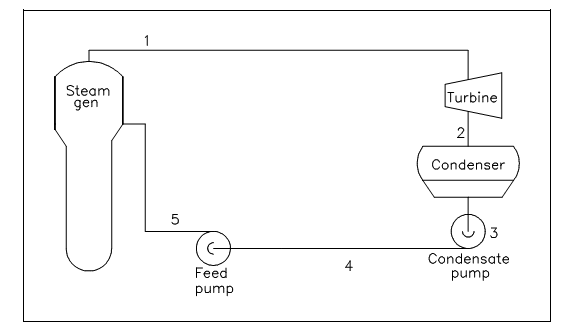Typical Steam Plant Cycle
Note that in the individual processes the fluid should go via before finishing the complete cycle. The figure below illustrates a typical steam plant cycle. The heat is supplied to the steam generator (i.e., boiler) where liquid is transformed to steam or vapor. The vapor is then expanded adiabatically in the turbine to generate a work outcome. The vapor leaving the turbine then comes into the condenser where heat is eliminated and the vapor is condensed into the liquid state. The condensation procedure is the heat-rejection method for the cycle. The Saturated liquid is delivered to the condensate pump and then the feed pump where its pressure is increased to the saturation pressure equivalent to the steam generator temperature, and the high pressure liquid is distributed to the steam generator where the cycle repeats itself.

Figure: Typical Steam Plant Cycle
With the illustration complete, it seems suitable to discuss the different components of a usual steam plant system. However such a system is tremendously complicated, only the main components will be studied. The typical steam plant system contains: a heat source to generate the thermal energy (example, nuclear or fossil fuel); a steam generator to modify the thermal energy into steam energy (i.e., a complete steam plant generally exists in relationship with the steam generator in transforming the steam into ultimate electrical energy); pumps to transfer the fluid back to the heat source (i.e., reactor coolant pumps in a nuclear reactor); a pressurize to make certain that the main system maintains its preferred pressure; and the essential piping to make certain the fluid passes via each stage of its cyclic procedure. Of requirement, the steam plant is a large "closed" system. Though, each component of the system is thermodynamically investigated as an open system since the fluid passes via it. Of primary significance is the process of dispersing the energy generated by the heat source. This procedure occurs in the steam generator that acts as a huge two-phase heat generator.
The hot fluid from the heat source passes via the main side of the steam generator where its energy is passed to the secondary side of the heat exchanger in such a way as to generate steam. The fluid, with its energy eliminated from the prime side, leaves the steam generator at an inferior temperature, and is pumped back to the heat source to be "re-heated." Each main component of a steam plant can be delighted as an individual open system problem. A thermodynamic analysis, using the different forms of energies, can be exerted to the specific component in studying its performance.